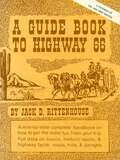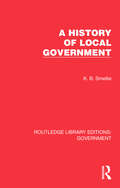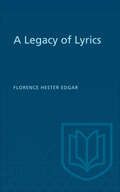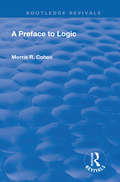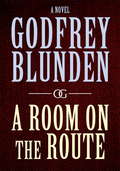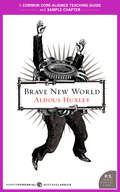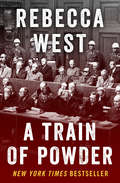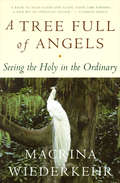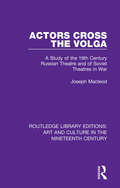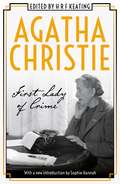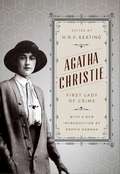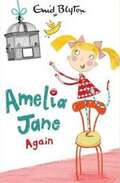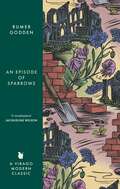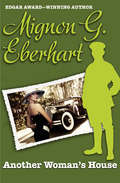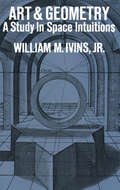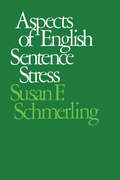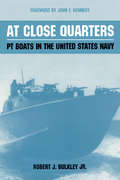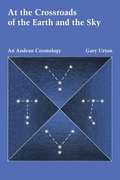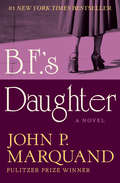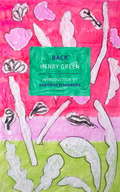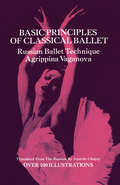- Table View
- List View
A Guide Book to Highway 66
by Jack D. RittenhouseThis is an exact facsimile of the first guidebook of its kind to the full length of the famous Route 66, from Chicago to Los Angeles. It was first published in 1946. Route 66 is part of American history now, and this guide is useful for those who wish to follow the old road in lieu of driving on the interstate highways that have replaced it. The book is divided into nine sections, corresponding to the journeys between stops by the average motorist. In addition, this structure makes the book useful to the traveler who wishes to follow only part of old US 66. Rittenhouse includes altitude and 1940 population figures for each town, with information on reliable garages, tourist courts (the forerunner's of today's motels), and other local attractions. This fascinating piece of Americana recalls a day before the arrival of franchised restaurants and hotels, when travel still held some surprises. Anyone driving in the West or recalling a trip in the good old days will enjoy it.
A History of Local Government (Routledge Library Editions: Government)
by K. B. SmellieOriginally published in 1946, this book traces the essential changes in structure, areas and in the relations between local and central authorities in England from 1832 to the Education Act of 1944. Modern English local government has developed from the industrial and scientific revolution and the growth of political democracy since 1832 and the present system is the result of an interplay between political, economic and scientific factors. The book contains a stand-alone chapter on London government and an introductory chapter on the condition of local government between 1689 and 1832.
A Legacy of Lyrics
by Florence Hester EdgarAfter Florence Hester Edgar passed away in 1944, there was found among her effects a quantity of compositions in prose and verse almost ready for publication. From this literary bequest has been selected the poetry that follows. Some poems were published in the daily press of Ottawa, and others in a small brochure. But most of the poems are now offered to the reading public for the first time, and the editor bespeaks for them a cordial reception.
A Preface to Logic (Routledge Revivals)
by Morris R. CohenPublished in 1946, this volume does not purpose to be a treatise on logic. The author’s contributions to the substance of logical doctrine have been made in his other works. What he has attempted in the studies that form this volume is an exploration of the periphery of logic, the relation of logic to the rest of the universe, the philosophical presuppositions which give logic its meaning and the applications which give it importance. It is his belief that formal logic is the heart of philosophy, since the subject matter of logic is the formal aspect of all being. From this standpoint he explores the relation of logic to such fields of study as natural science, ethics, history and general philosophy.
A Room on the Route
by Godfrey BlundenThis is the story of lives under the constant scrutiny of the N.K.V.D.Here is a monumental novel that shows how the fantastic Communist will-to-power has led to the enslavement of the Russians themselves. Here are the intellectuals, factory workers, spies, soldiers, big-shot Communists, and plain family people. This is the story of their lives under the constant scrutiny of the N.K.V.D. as told by expert author Godfrey Blunden.
A Room on the Route
by Godfrey BlundenThis is the story of lives under the constant scrutiny of the N.K.V.D.Here is a monumental novel that shows how the fantastic Communist will-to-power has led to the enslavement of the Russians themselves. Here are the intellectuals, factory workers, spies, soldiers, big-shot Communists, and plain family people. This is the story of their lives under the constant scrutiny of the N.K.V.D. as told by expert author Godfrey Blunden.
A Teacher's Guide to Brave New World
by Aldous Huxley Amy JurskisFor teachersWe know that the Common Core State Standards are encouraging you to reevaluate the books that you assign to your students. To help you decide which books are right for your classroom, each free ebook in this series contains a Common Core-aligned teaching guide and a sample chapter.This free teaching guide for Brave New World by Aldous Huxley is designed to help you put the new Common Core State Standards into practice."Aldous Huxley is the greatest 20th century writer in English."--Chicago TribuneAldous Huxley's tour de force, Brave New World is a darkly satiric vision of a "utopian" future--where humans are genetically bred and pharmaceutically anesthetized to passively serve a ruling order. A powerful work of speculative fiction that has enthralled and terrified students for generations, it remains remarkably relevant to this day as both a warning to be heeded as we head into tomorrow and as thought-provoking, satisfying entertainment.
A Train of Powder
by Rebecca WestA New York Times bestseller, this riveting account of the Nuremberg trials by a legendary journalist is simply &“astonishing&” (Francine Prose). Sent to cover the war crimes trials at Nuremberg for the New Yorker, Rebecca West brought along her inimitable skills for understanding a place and its people. In these accomplished articles, West captures the world that sprung up to process the Nazi leaders; from the city&’s war-torn structures to the courtroom security measures, no detail is left out. West&’s unparalleled grasp on human motivations and character offers particular insight into the judges, prosecutors, and of course the defendants themselves. This remarkable narrative captures the social and political ramifications of a world recovering from the divisions of war. As engaging as it is informative, this collection represents West&’s finest hour as a reporter.
A Tree Full of Angels
by Macrina WiederkehrThe Benedictine tradition and practice of divine reading made accessible for everyone.
Actors Cross the Volga: A Study of the 19th Century Russian Theatre and of Soviet Theatres in War (Routledge Library Editions: Art and Culture in the Nineteenth Century #6)
by Joseph MacleodFirst published in 1946. In this study of Russian theatre, the author explores the developments of drama and the theatre throughout the nineteenth-century. Macleod examines imperial and serf theatres, the impact of Russian drama on the east and west, and the regeneration of theatre at the start of the twentieth-century. This title will be of great interest to students of Theatre Studies and Russian History.
Agatha Christie: First Lady Of Crime
by Agatha ChristieIncludes a new introduction from Sophie Hannah, bestselling author of THE MONOGRAM MURDERS
Agatha Christie: First Lady of Crime
by Agatha ChristieIncludes a new introduction from Sophie Hannah, bestselling author of THE MONOGRAM MURDERS and HAVEN'T THEY GROWNAgatha Christie was not only the biggest selling writer of detective stories the world has ever known, she was also a mystery in herself, giving only the rarest interviews, declining absolutely to become any sort of public figure, and a mystery too in the manner in which she achieved her astonishing success.H R F Keating, a crime novelist and respected reviewer of crime fiction, brought together a dozen distinguished writers from both sides of the Atlantic to throw light on this double mystery. Some analyse the art itself; some explain the reasons for her success, not just the books, but also in film and theatre.The approaches are penetrating, affectionate, enthusiastic, analytical, funny - even critical. Together, they give an almost unique insight into the life and work of the First Lady of Crime.
Agatha Christie: First Lady of Crime
by Agatha ChristieFrom Poirot to Miss Marple, from The Mousetrap to Witness for the Prosecution, this a fascinating look at the life and work of Agatha Christie, the world's most successful and popular crime writer.Agatha Christie was not only the most successful author of detective stories the world has ever known, she was also a mystery in herself, giving only the rarest interviews—declining absolutely to become any sort of public figure—and a mystery, too, in the manner in which she achieved her astonishing success. Distinguished crime novelist (and acclaimed critic) H. R. F. Keating brings together a dozen noted writers from both sides of the Atlantic to throw light on the ever-intriguing Dame Agatha. Some essays analyze Christie&’s art itself; some explain the reasons for her success—not just the books, but also in film and theatre. The myriad of critical angles explored here are penetrating, affectionate, enthusiastic, analytical, and even funny. Together, they give an almost unique insight into the life and work of the First Lady of Crime. Includes essays by Sophie Hannah, H. R. F. Keating, Elizabeth Walter, Julian Symons, Edmund Crispin, Michael Gilbert, Emma Lathen, Colin Watson, Celia Fremlin, Dorothy B. Hughes, J. C. Trewin, Philip Jenkinson, William Weaver, and Christianna Brand.
Amelia Jane Again!: Book 2 (Amelia Jane #2)
by Enid BlytonEnid Blyton's Amelia Jane is big, bad and the world's naughtiest toy!Look out! First Amelia upsets the toys terribly with her mischief and then she gets poor Teddy to carry her home without him having a clue. Will the toys get their own back?First published in 1946, this edition contains the classic text and illustrations by Deborah Allwright, cover by Alex T. Smith (2011).
An Episode of Sparrows: A Virago Modern Classic
by Rumer GoddenBy the author of Black NarcissusWith a foreword by JACQUELINE WILSON'A masterpiece of construction and utterly realistically convincing...Rumer Godden's writing is admired for many qualities . . . but I think her greatest strength is her accurate, unsentimental portrayal of children. Lovejoy, Tip and Sparkey were so real to me that they have stayed alive in my head for more than fifty years' Jacqueline WilsonA captivating classic novel of a poor girl striving to create beauty among the bombsites of post-war London.Someone has been digging up the private garden in the Square. Miss Angela Chesney of the Garden Committee is sure that a gang of local boys is to blame, but her sister, Olivia, isn't so sure. She wonders why the neighbourhood children - 'sparrows', she calls them - have to be locked out: don't they have a right to enjoy the garden too?Nobody has any idea what sends Lovejoy Mason and her few friends in search of 'good garden earth'. Still less do they imagine where their investigation will lead them - to a struggling restaurant, a bombed-out church, and, at the heart of it all, a hidden garden.
An Episode of Sparrows: A Virago Modern Classic (Virago Modern Classics #157)
by Rumer GoddenBy the author of Black NarcissusWith a foreword by JACQUELINE WILSON'A masterpiece of construction and utterly realistically convincing...Rumer Godden's writing is admired for many qualities . . . but I think her greatest strength is her accurate, unsentimental portrayal of children. Lovejoy, Tip and Sparkey were so real to me that they have stayed alive in my head for more than fifty years' Jacqueline Wilson A captivating classic novel of a poor girl striving to create beauty among the bombsites of post-war London.Someone has been digging up the private garden in the Square. Miss Angela Chesney of the Garden Committee is sure that a gang of local boys is to blame, but her sister, Olivia, isn't so sure. She wonders why the neighbourhood children - 'sparrows', she calls them - have to be locked out: don't they have a right to enjoy the garden too?Nobody has any idea what sends Lovejoy Mason and her few friends in search of 'good garden earth'. Still less do they imagine where their investigation will lead them - to a struggling restaurant, a bombed-out church, and, at the heart of it all, a hidden garden.
Annual Report of Executive Directors
by International Monetary FundA report from the International Monetary Fund.
Another Woman's House
by Mignon G. EberhartA young girl is consumed by love for a tortured married manMyra has lived at Thorne House for so long that she almost feels part of the family. Orphaned at a young age, she has never known another home, and yet it is time for her to leave. She is burning with an irresistible passion for Richard, the man of the house, and she knows that her love can never be fulfilled. For Richard is married to Alice, and Alice is guilty of murder. Myra knows that Richard is too noble to ask an incarcerated woman for a divorce, but on the eve of her departure he surprises her, confessing that he loves her in return. Just as Myra&’s future happiness seems assured, Alice returns to crush it. The convicted killer is back at Thorne House, and blood will follow in her wake.
Art and Geometry: A Study in Space Intuitions
by William M. IvinsOne of Western civilization's jealously guarded myths is that of Greek cultural supremacy. In this controversial study, William Ivins shows that the limitations of the Greek worldview actually hampered the development of the arts and sciences and gives a stimulating history of the new ideas of the Renaissance, especially in painting and geometry, that freed us from ancient misconceptions. Beginning with the Greeks, the author explains for the general reader the differences between ancient and Renaissance painting and sculpture, proving that the curiously static quality of Greek art arose from a misunderstanding of the laws of perspective. He then shows how this misunderstanding was corrected by Alberti, Pelerin, Durer, and other Renaissance artists who provided the first fruitful investigations of perspective. From there to projective geometry was but a step, and the author covers this major advance in our knowledge through the work of Nicholas of Cusa, Kepler, and Desargues. This book is perhaps the only concise history in English of the development of mathematical perspective and projective geometry. But the author's ability to relate styles in art to advances in geometry and his ingenious theory of the modern "visual" worldview and the Greek "tactile" worldview mean that his book will be provocative not only to mathematical historians but also to art historians and to anyone concerned with the history of thought, from philosopher to layman.
Aspects of English Sentence Stress
by Susan F. SchmerlingAspects of English Sentence Stress is written within the conceptual framework of generative-transformational grammar. However, it is atheoretical in the sense that the proposals made cannot be formulated in this theory and are a challenge to many other theories. The author's concern is not with the phonetic nature of stress; rather, using a working definition of stress as subjective impression of prominence, she attempts to formulate general principles that will predict the relative prominence of different words in particular utterances-what might be called the syntax of stress. She supports her arguments with a large amount of original data and provides the basis for new ways of thinking about this area of linguistic research. Schmerling begins with a detailed review and critique of Noam Chomsky and Morris Halle's approach to sentence stress; she shows that their cyclic analysis cannot be considered valid, even for quite simple phrases and sentences. Next, she reviews discussions of sentence stress by Joan Bresnan, George Lakoff, and Dwight Bolinger, agreeing with Bolinger's contention that there is no intimate connection between sentence stress and syntactic structure but showing that his counterproposal to the standard approach is inadequate as well. She also examines the concept of "normal stress" and demonstrates that no linguistically significant distinction can be drawn between "normal" and "special" stress contours. In generating her own proposals concerning sentence stress, Professor Schmerling takes the view that certain items which are stressable are taken for granted by the speaker and are eliminated from consideration by the principles governing relative prominence of words in a sentence. Then she examines the pragmatic and phonological principles pertaining to items that are not eliminated from consideration. Finally, the author contends that the standard views, which she shows to be untenable, are a result of the assumption that linguistic entities should be studied apart from questions concerning their use, in that it was adoption of this methodological assumption that forced linguists to deny the essentially pragmatic nature of sentence stress. Accessible to anyone who is familiar with the basic concepts of generative-transformational grammar, Aspects of English Sentence Stress presents provocative ideas in the field.
At Close Quarters
by Robert J. BulkleySmall though they were, PT boats played a key role in World War II, carrying out an astonishing variety of missions where fast, versatile, and strongly armed vessels were needed. Called "weapons of opportunity," they met the enemy at closer quarters and with greater frequency than any other type of surface craft. Among the most famous PT commanders was John F. Kennedy, whose courageous actions in the Pacific are now well known to the American public. The author of the book, another distinguished PT boat commander in the Pacific, compiled this history of PT-boat operations in World War II for the U.S. Navy shortly after V-J Day, when memories were fresh and records easily assessable. The book was first made available to the public in 1962 after Kennedy's inauguration as president of the United States interest in PTs was at a peak.Bulkley provides a wealth of facts about these motor torpedo boats, whose vast range of operation covered two oceans as well as the Mediterranean and the English Channel. Although their primary mission was to attack surface ships and craft close to shore, they were also used effectively to lay mines and smoke screens, to rescue downed aviators, and to carry out intelligence and raider operations. The author gives special attention to the crews, paying well-deserved tribute to their heroism, skill, and sacrifice that helped to win the war.
At the Crossroads of the Earth and the Sky: An Andean Cosmology
by Gary UrtonBased on fieldwork in Misminay, Peru, Gary Urton details a cosmology in which the Milky Way is central. This is the first study that provides a description and analysis of the astronomical and cosmological system in a contemporary community in the Americas.
B.F.'s Daughter: A Novel
by John P. MarquandThe daughter of a powerful industrialist seeks to live on her own terms in this entertaining portrait of the American home front during World War II Polly Fulton, the daughter of one of America's most successful and admired businessmen, lives with her parents and brother in a thirty-room apartment on New York City's Park Avenue. Yet she despises the superficial trappings of wealth and delights in defying convention. In the months before America enters World War II, she shocks her family and friends by dumping her longtime boyfriend, Bob Tasmin, and marrying radical journalist Tom Brett. As the war rages on the other side of the globe and dominates the thoughts of everyone at home, Polly comes to realize that she acted out of pride and contrariness, not love. But with Bob stationed in Guam, it may be too late to correct her terrible mistake. A richly detailed, elegantly crafted tale about the search for happiness in the chaos of wartime, B.F.'s Daughter is one of John P. Marquand's warmest and most empathetic novels.
Back
by Henry Green Deborah EisenbergBack is the story of Charley Summers, who is back from the war and a POW camp having lost the woman he loved, Rose, to illness before he left and his leg to fighting. In other words, Charley has very little to come back to, only memories, and on top of that he has been deeply traumatized by his experience of war. Rose's father introduces him to another young woman, Nancy, and Charley becomes convinced that she is in fact Rose and pursues her. Back is at once a Shakespearean comedy of mistaken identities, a voyage into the world of madness, and a celebration of the improbable healing powers of love.
Basic Principles of Classical Ballet: Russian Ballet Technique
by Agrippina VaganovaAlthough the stars of Russian ballet Anna Pavlova and Tamara Karsavina possessed a national manner of dancing, there was no truly Russian school of dancing until the 1930s. The development of this school was largely due to Mme. Vaganova (1879–1951), not only a great dancer but also the teacher of Galina Ulanova and many others and an unsurpassed theoretician.The principles of Vaganova's system are presented in this well-known book. Mme. Vaganova's aim of creating a personal approach to the Russian dance was based on the critical assimilation of the experience of her contemporaries. Her ability to choose the best of what had been accomplished in the various ballet traditions (French, Italian, and Russian) and combine these into a unified teaching practice in itself amounted to a new school of dance. She firmly believed that the teaching process should be a planned exercise, ever changing with innovations in the dance. She sought from her pupils emotional expressiveness, strictness of form, a resolute, energetic manner of performance, and the understanding of the underlying coordination of movements.Her book discusses all basic principles of ballet, grouping movements by fundamental types. Chapters cover battements, rotary movements of the legs, the arms, poses of the classical dance, connecting and auxiliary movements, jumps, beats, point work, and turns as well as material for a sample lesson. Diagrams show clearly the exact foot, leg, arm, and body positions for the proper execution of many steps and movements. The result is a fundamental theory of dance that offers dancers, teachers, and ballet lovers information often difficult to locate in other books. 118 illustrations.
